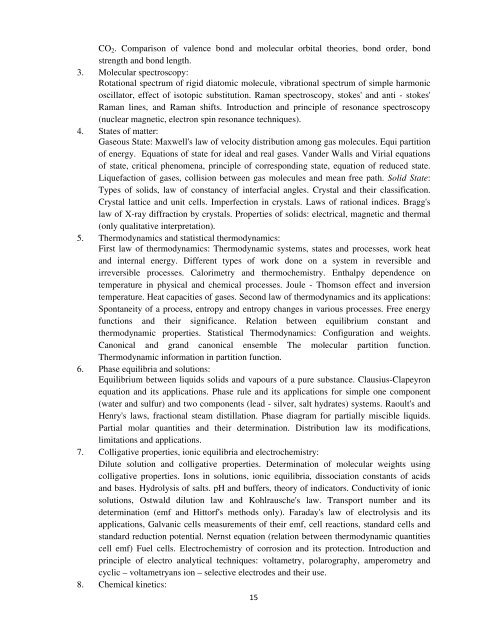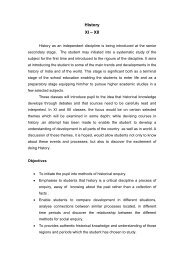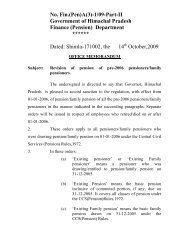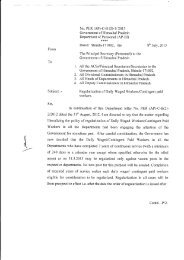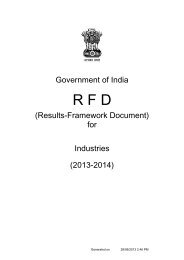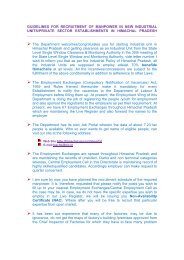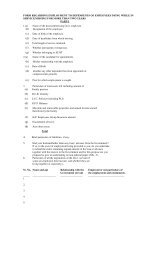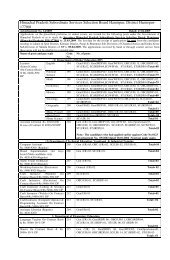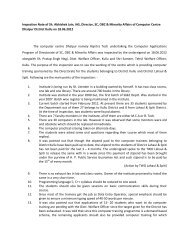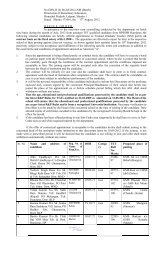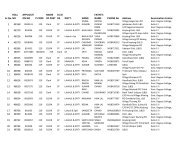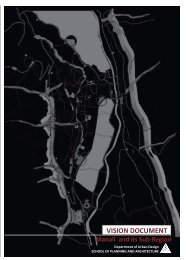II) Plant Physiology and Biochemistry: Absorption and Conduction of Water. MineralAbsorption. Role of elements and mineral deficiencies. Transpiration. Mechanisms ofstomatal movements. Respiration. Photorespiration. Photosynthesis. Anatomy of C 3 andC 4 plants. Nitrogen fixation. Nitrogen metabolism. Enzymes and coenzymes. PlantGrowth and Movements. Photoperiodism and Vernalization. Plant Hormones.Dormancy and germination of seeds. Photomorphogenesis. Stress physiology withrespect to temperature, water and salinity stress. Physiology of flowering. Fruit ripening.Chemical foundations of biology: Physico-chemical properties of water, pH, acids, bases,buffers, types of bonds and their importance, free energy, resonance and isomerisation.Structure and functions of Carbohydrates, Lipids/Fats, Amino acids, Peptides, Proteinsand Nucleic acids.III) Cell Biology, Genetics, Evolution, Molecular Biology and Biotechnology: Techniques ofcell biology, Prokaryotic and eukaryotic cells. Cell theory. Cell as a unit of structure andfunction, ultra-structure of cell and its various organelles (chloroplasts, mitochondria,endoplasmic, reticulum, ribosomes, endosomes, vacuoles, lysosomes, peroxysomes).Extracellular matrix or ECM. Cell wall and plasma membrane. Nucleus, Nucleolus,Nuclear pore complex (NPC), Chromatin and Nucleosome. Nucleic acids − their structure,reproduction and role in protein biosynthesis. DNA polymorphism. The physical andchemical structure of chromosomes. Mitosis and Meiosis. Molecular control involvingcheck points in cell division cycle. Structural and Numerical changes in chromosomes.Structure, behaviour and significance of polytene, lampbrush and B-chromosomes. Preand Post Mendelian concept of Genetics. Laws of inheritance. Chromosome theory ofinheritance. Gene and Allele concepts. Linkage, Crossing over and Gene mapping.Genetic Code. Regulation of gene expression. Sex chromosomes and sex-linkedinheritance. Sex determination. Biochemical and molecular basis of Mutations. Extrachromosomal / Cytoplasmic inheritance. Evidences, Mechanisms and Theories of organicevolution. Micropropagation. Cell, tissue, organ and protoplast culture. Geneticengineering. Methods of gene transfer and transgenic crops. Development and use ofmolecular markers. Fermentation technology. Biofertilizers.CHEMISTRYPAPER-I1. Quantum mechanics:Plank's hypothesis of quantization of energy. Implications of Plank' hypothesis for black -body radiation, heat capacities of solids, photoelectric effect. wave - particle duality andHeisenberg uncertainty principle. The wave function, information in a wave function,normalization of wave function. Eign values and eign functions. Operators, postulates ofquantum mechanics (principals and introduction). Schrodinger wave equation for freeparticle and particle in one dimension and three dimension box. Schrodinger waveequation for hydrogen atom, radial and probability wave function.2. Chemical bonding:Ionic bond, characteristics of ionic compounds, factors affecting stability of ioniccompounds, lattice energy, Born-Haber cycle; covalent bond and its generalcharacteristics, polarities of bonds in molecules and their dipole moments Valence bondtheory, concept of resonance and resonance energy. Molecular orbital theory, (LCAOmethod); bonding in homonuclear molecules: H + 2 , H 2 to Ne 2 , NO, CO, HF, CN, BeH 2 and
CO 2 . Comparison of valence bond and molecular orbital theories, bond order, bondstrength and bond length.3. Molecular spectroscopy:Rotational spectrum of rigid diatomic molecule, vibrational spectrum of simple harmonicoscillator, effect of isotopic substitution. Raman spectroscopy, stokes' and anti - stokes'Raman lines, and Raman shifts. Introduction and principle of resonance spectroscopy(nuclear magnetic, electron spin resonance techniques).4. States of matter:Gaseous State: Maxwell's law of velocity distribution among gas molecules. Equi partitionof energy. Equations of state for ideal and real gases. Vander Walls and Virial equationsof state, critical phenomena, principle of corresponding state, equation of reduced state.Liquefaction of gases, collision between gas molecules and mean free path. Solid State:Types of solids, law of constancy of interfacial angles. Crystal and their classification.Crystal lattice and unit cells. Imperfection in crystals. Laws of rational indices. Bragg'slaw of X-ray diffraction by crystals. Properties of solids: electrical, magnetic and thermal(only qualitative interpretation).5. Thermodynamics and statistical thermodynamics:First law of thermodynamics: Thermodynamic systems, states and processes, work heatand internal energy. Different types of work done on a system in reversible andirreversible processes. Calorimetry and thermochemistry. Enthalpy dependence ontemperature in physical and chemical processes. Joule - Thomson effect and inversiontemperature. Heat capacities of gases. Second law of thermodynamics and its applications:Spontaneity of a process, entropy and entropy changes in various processes. Free energyfunctions and their significance. Relation between equilibrium constant andthermodynamic properties. Statistical Thermodynamics: Configuration and weights.Canonical and grand canonical ensemble The molecular partition function.Thermodynamic information in partition function.6. Phase equilibria and solutions:Equilibrium between liquids solids and vapours of a pure substance. Clausius-Clapeyronequation and its applications. Phase rule and its applications for simple one component(water and sulfur) and two components (lead - silver, salt hydrates) systems. Raoult's andHenry's laws, fractional steam distillation. Phase diagram for partially miscible liquids.Partial molar quantities and their determination. Distribution law its modifications,limitations and applications.7. Colligative properties, ionic equilibria and electrochemistry:Dilute solution and colligative properties. Determination of molecular weights usingcolligative properties. Ions in solutions, ionic equilibria, dissociation constants of acidsand bases. Hydrolysis of salts. pH and buffers, theory of indicators. Conductivity of ionicsolutions, Ostwald dilution law and Kohlrausche's law. Transport number and itsdetermination (emf and Hittorf's methods only). Faraday's law of electrolysis and itsapplications, Galvanic cells measurements of their emf, cell reactions, standard cells andstandard reduction potential. Nernst equation (relation between thermodynamic quantitiescell emf) Fuel cells. Electrochemistry of corrosion and its protection. Introduction andprinciple of electro analytical techniques: voltametry, polarography, amperometry andcyclic – voltametryans ion – selective electrodes and their use.8. Chemical kinetics:
- Page 1 and 2: (-IV ): (-4 )-(3 )-1 /2012 -171002
- Page 3 and 4: the interview is to assess the pers
- Page 5 and 6: protection equipment, their care an
- Page 7 and 8: 5.2 By products: Slaughter house by
- Page 9 and 10: (a) Paleolithic(b) Mesolithic(c) Ne
- Page 11 and 12: 10.1 Relevance in understanding of
- Page 13: III)anatomy of root, stem and leaf.
- Page 17 and 18: Reactions in liquid NH 3 , HF, SO 2
- Page 19 and 20: indeterminate arches, spandrel brac
- Page 21 and 22: Meaning and Scope of Accounting: Ne
- Page 23 and 24: Business Environment: Macro and Mic
- Page 25 and 26: Functioning of money market in Indi
- Page 27 and 28: IC Technology:Overview of IC Techno
- Page 29 and 30: - The Road not taken- After Apple P
- Page 31 and 32: erosion, interruption in the cycle
- Page 33 and 34: polymorphism. Trace elements. Magma
- Page 35 and 36: Extension education and its importa
- Page 37 and 38: 10. Towards Contemporary World: Som
- Page 39 and 40: Marketing Management - Marketing an
- Page 41 and 42: Forces in three dimensions, Poinsot
- Page 43 and 44: Theory of Machines: Displacement, v
- Page 45 and 46: (a) Position, parts, relations, blo
- Page 47 and 48: (a) Carbohydrate, lipid and amino a
- Page 49 and 50: RESPIRATORY SYSTEM1. Lung volumes a
- Page 51 and 52: High Court, Session Court, Magistra
- Page 53 and 54: 3. MEDICAL JURISPRUNDENCE1. Medical
- Page 55 and 56: - Transport media- Description of c
- Page 57 and 58: ) Bacterial diseases : Pyogenic, Ty
- Page 59 and 60: c) Cirrhosis: Etiology, Postnecroti
- Page 61 and 62: (G) Hormonesa) Reproductive hormone
- Page 63 and 64: - Proportions- Risk- Sources of epi
- Page 65 and 66:
- Legal status in relation to Workm
- Page 67 and 68:
- DrugsBipolar disordersDepressive
- Page 69 and 70:
_ Aspergillosis_ Histoplasmosis_ Cr
- Page 71 and 72:
_ Clinical examination of the abdom
- Page 73 and 74:
_ Venous thrombosis_ Abnormal coagu
- Page 75 and 76:
14. Biochemical and endocrine chang
- Page 77 and 78:
Disorder-Causes and types of convul
- Page 79 and 80:
12. Peritoneum and intraperitoneal
- Page 81 and 82:
• Nutritional disorders• Incomi
- Page 83 and 84:
types equation of motion under cent
- Page 85 and 86:
3. Indian System of Government:(a)
- Page 87 and 88:
Techniques of assessment (Psychomet
- Page 89 and 90:
Effect of noise, pollution and atmo
- Page 91 and 92:
12. Major issues in Indian Administ
- Page 93 and 94:
2. Uttararamacaritam (Act 1st Verse
- Page 95 and 96:
PAPER-II(i) Hypothesis; Meaning, Fu
- Page 97 and 98:
insects, metamorphosis,mouth parts,


